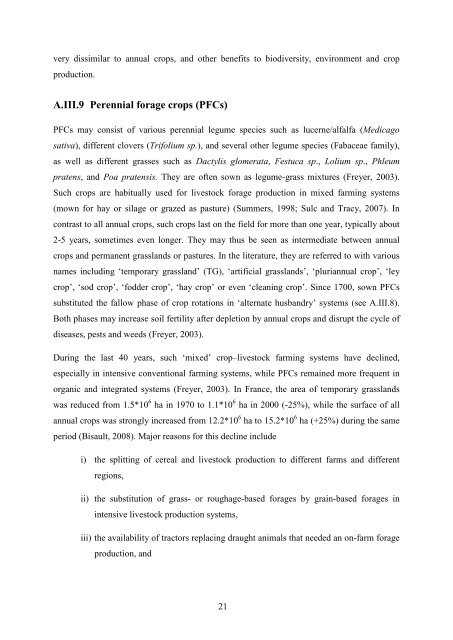Diversifying crop rotations with temporary grasslands - Université de ...
Diversifying crop rotations with temporary grasslands - Université de ...
Diversifying crop rotations with temporary grasslands - Université de ...
Create successful ePaper yourself
Turn your PDF publications into a flip-book with our unique Google optimized e-Paper software.
very dissimilar to annual <strong>crop</strong>s, and other benefits to biodiversity, environment and <strong>crop</strong><br />
production.<br />
A.III.9 Perennial forage <strong>crop</strong>s (PFCs)<br />
PFCs may consist of various perennial legume species such as lucerne/alfalfa (Medicago<br />
sativa), different clovers (Trifolium sp.), and several other legume species (Fabaceae family),<br />
as well as different grasses such as Dactylis glomerata, Festuca sp., Lolium sp., Phleum<br />
pratens, and Poa pratensis. They are often sown as legume-grass mixtures (Freyer, 2003).<br />
Such <strong>crop</strong>s are habitually used for livestock forage production in mixed farming systems<br />
(mown for hay or silage or grazed as pasture) (Summers, 1998; Sulc and Tracy, 2007). In<br />
contrast to all annual <strong>crop</strong>s, such <strong>crop</strong>s last on the field for more than one year, typically about<br />
2-5 years, sometimes even longer. They may thus be seen as intermediate between annual<br />
<strong>crop</strong>s and permanent <strong>grasslands</strong> or pastures. In the literature, they are referred to <strong>with</strong> various<br />
names including ‘<strong>temporary</strong> grassland’ (TG), ‘artificial <strong>grasslands</strong>’, ‘pluriannual <strong>crop</strong>’, ‘ley<br />
<strong>crop</strong>’, ‘sod <strong>crop</strong>’, ‘fod<strong>de</strong>r <strong>crop</strong>’, ‘hay <strong>crop</strong>’ or even ‘cleaning <strong>crop</strong>’. Since 1700, sown PFCs<br />
substituted the fallow phase of <strong>crop</strong> <strong>rotations</strong> in ‘alternate husbandry’ systems (see A.III.8).<br />
Both phases may increase soil fertility after <strong>de</strong>pletion by annual <strong>crop</strong>s and disrupt the cycle of<br />
diseases, pests and weeds (Freyer, 2003).<br />
During the last 40 years, such ‘mixed’ <strong>crop</strong>–livestock farming systems have <strong>de</strong>clined,<br />
especially in intensive conventional farming systems, while PFCs remained more frequent in<br />
organic and integrated systems (Freyer, 2003). In France, the area of <strong>temporary</strong> <strong>grasslands</strong><br />
was reduced from 1.5*10 6 ha in 1970 to 1.1*10 6 ha in 2000 (-25%), while the surface of all<br />
annual <strong>crop</strong>s was strongly increased from 12.2*10 6 ha to 15.2*10 6<br />
ha (+25%) during the same<br />
period (Bisault, 2008). Major reasons for this <strong>de</strong>cline inclu<strong>de</strong><br />
i) the splitting of cereal and livestock production to different farms and different<br />
regions,<br />
ii) the substitution of grass- or roughage-based forages by grain-based forages in<br />
intensive livestock production systems,<br />
iii) the availability of tractors replacing draught animals that nee<strong>de</strong>d an on-farm forage<br />
production, and<br />
21

















